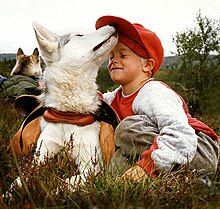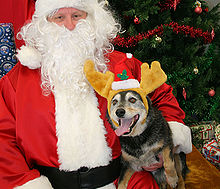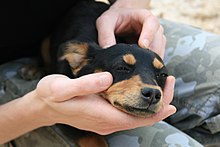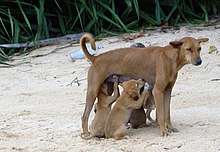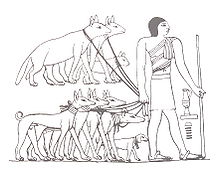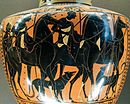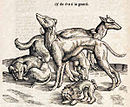From Wikipedia, the free encyclopedia
| Domestic dog Temporal range: 0.033–0Ma
↓
|
|
|---|---|
 |
|
| Nine different breeds of dogs. | |
| Conservation status | |
Domesticated
|
|
| Scientific classification | |
| Kingdom: | Animalia |
| Phylum: | Chordata |
| Class: | Mammalia |
| Order: | Carnivora |
| Family: | Canidae |
| Genus: | Canis |
| Species: | C. lupus |
| Subspecies: | C. l. familiaris |
| Trinomial name | |
| Canis lupus familiaris[1] | |
| Synonyms | |
The term "domestic dog" is generally used for both of the domesticated and feral varieties. The English word dog comes from Middle English dogge, from Old English docga, a "powerful dog breed".[9] The term may possibly derive from Proto-Germanic *dukkōn, represented in Old English finger-docce ("finger-muscle").[10] The word also shows the familiar petname diminutive -ga also seen in frogga "frog", picga "pig", stagga "stag", wicga "beetle, worm", among others.[11] The term dog may ultimately derive from the earliest layer of Proto-Indo-European vocabulary, reflecting the role of the dog as the earliest domesticated animal.[12]
In 14th-century England, hound (from Old English: hund) was the general word for all domestic canines, and dog referred to a subtype of hound, a group including the mastiff. It is believed this "dog" type was so common, it eventually became the prototype of the category "hound".[13] By the 16th century, dog had become the general word, and hound had begun to refer only to types used for hunting.[14] Hound, cognate to German Hund, Dutch hond, common Scandinavian hund, and Icelandic hundur, is ultimately derived from the Proto-Indo-European *kwon- "dog", found in Sanskrit kukuur (कुक्कुर),[15] Welsh ci (plural cwn), Latin canis, Greek kýōn, and Lithuanian šuõ.[16]
In breeding circles, a male canine is referred to as a dog, while a female is called a bitch[17] (Middle English bicche, from Old English bicce, ultimately from Old Norse bikkja). A group of offspring is a litter. The father of a litter is called the sire, and the mother is called the dam. Offspring are, in general, called pups or puppies, from French poupée, until they are about a year old. The process of birth is whelping, from the Old English word hwelp (cf. German Welpe, Dutch welp, Swedish valpa, Icelandic hvelpur).[18] The term "whelp" can also be used to refer to the young of any canid, or as a (somewhat archaic) alternative to "puppy".
Taxonomy
In 1753, Carl Linnaeus listed among the types of quadrupeds familiar to him the Latin word for dog, canis. Among the species within this genus, Linnaeus listed the fox, as Canis vulpes, wolves (Canis lupus), and the domestic dog, (Canis canis). In later editions, Linnaeus dropped Canis canis and greatly expanded his list of the Canis genus of quadrupeds, and by 1758 included alongside the foxes, wolves, and jackals and many more terms that are now listed as synonyms for domestic dog, including aegyptius (hairless dog), aquaticus, (water dog), and mustelinus (literally "badger dog"). Among these were two that later experts have been widely used for domestic dogs as a species: Canis domesticus and, most predominantly, Canis familiaris, the "common" or "familiar" dog.[19]By 1993 with advancements in molecular biology, the mitochondrial DNA mtDNA analysis of extant (i.e. living today) Canidea species indicated that "The domestic dog is an extremely close relative of the gray wolf, differing from it by at most 0.2% of mtDNA sequence.... In comparison, the gray wolf differs from its closest wild relative, the coyote, by about 4% of mitochondrial DNA sequence."[20] In the same year, the domestic dog Canis familiaris was reclassified as Canis lupus familiaris, a subspecies of the gray wolf Canis lupus in Mammal Species of the World.[21] By 1999, further genetic analysis indicated that the domestic dog may have emerged from multiple wolf populations.[22][23] Based on these latest two pieces of research and the reference reclassification, canis lupus familiaris is the name for the taxon listed by ITIS.[24] However, canis familiaris is also accepted due to a nomenclature debate regarding the naming of wild and domestic sub-species.[25]
As of January 2014, a mtDNA study of extant and extinct dog and wolf specimens raises a question about this classification. Refer Origin and Gray wolf.
Origin
The domestic dog (Canis lupus familiaris or Canis familiaris), based on nuclear DNA evidence as of January 2014, began from a single domestication 11 to 16 thousand years ago that predates the rise of agriculture and implies that the earliest dogs arose along with hunter-gatherers and not agriculturists.[26] Mitochondrial DNA evidence as of November 2013 indicates that all modern dogs are most closely related to the extant and extinct canids of Europe[27][28] compared to earlier writers who proposed the origins from Eurasia as well as Eastern Asia.[29][30][31]The analysis indicates that the dog is not a descendant of the extant (i.e. living) gray wolf but forms a sister clade, and that dogs were originally domesticated from a now-extinct wolf population that was more genetically diverse than today’s wolf population. The dog's genetic closeness to modern wolves is due to admixture.[26][32]
Conceivably, proto-dogs might have taken advantage of carcasses left by early hunters, assisted in the capture of prey, or provided defense from large competing predators at kills. Furthermore, several ancient dogs may represent failed domestication events, such as the 36,000 year old Goyet specimen of Belgium and the 33,000 year old Altai Mountains specimen from Russia, as they have no descendents today.[27][33]
Roles with humans
Domestic dogs inherited complex behaviors, such as bite inhibition, from their wolf ancestors, which would have been pack hunters with complex body language. These sophisticated forms of social cognition and communication may account for their trainability, playfulness, and ability to fit into human households and social situations, and these attributes have given dogs a relationship with humans that has enabled them to become one of the most successful species on the planet today.[34]:pages95-136
The dogs' value to early human hunter-gatherers led to them quickly becoming ubiquitous across world cultures. Dogs perform many roles for people, such as hunting, herding, pulling loads, protection, assisting police and military, companionship, and, more recently, aiding handicapped individuals. This impact on human society has given them the nickname "man's best friend" in the Western world. In some cultures, however, dogs are also a source of meat.[35][36]
Early roles
Wolves, and their dog descendants, would have derived significant benefits from living in human camps—more safety, more reliable food, lesser caloric needs, and more chance to breed.[37] They would have benefited from humans' upright gait that gives them larger range over which to see potential predators and prey, as well as color vision that, at least by day, gives humans better visual discrimination.[37] Camp dogs would also have benefited from human tool use, as in bringing down larger prey and controlling fire for a range of purposes.[37]Humans would also have derived enormous benefit from the dogs associated with their camps.[38] For instance, dogs would have improved sanitation by cleaning up food scraps.[38] Dogs may have provided warmth, as referred to in the Australian Aboriginal expression "three dog night" (an exceptionally cold night), and they would have alerted the camp to the presence of predators or strangers, using their acute hearing to provide an early warning.[38]
Anthropologists believe the most significant benefit would have been the use of dogs' robust sense of smell to assist with the hunt.[38] The relationship between the presence of a dog and success in the hunt is often mentioned as a primary reason for the domestication of the wolf, and a 2004 study of hunter groups with and without a dog gives quantitative support to the hypothesis that the benefits of cooperative hunting was an important factor in wolf domestication.[39]
The cohabitation of dogs and humans would have greatly improved the chances of survival for early human groups, and the domestication of dogs may have been one of the key forces that led to human success.[40]
Emigrants from Siberia likely crossed the Bering land bridge with dogs in their company, and some experts[41] suggest the use of sled dogs may have been critical to the success of the waves that entered North America roughly 12,000 years ago,[41] although the earliest archaeological evidence of dog-like canids in North America dates from about 9,400 years ago.[34]:104[42] Dogs were an important part of life for the Athabascan population in North America, and were their only domesticated animal. Dogs also carried much of the load in the migration of the Apache and Navajo tribes 1,400 years ago. Use of dogs as pack animals in these cultures often persisted after the introduction of the horse to North America.[43]
As pets
"The most widespread form of interspecies bonding occurs between humans and dogs"[38] and the keeping of dogs as companions, particularly by elites, has a long history.[44] (As a possible example, at the Natufian culture site of Ain Mallaha in Israel, dated to 12,000 BC, the remains of an elderly human and a four-to-five-month-old puppy were found buried together).[45] However, pet dog populations grew significantly after World War II as suburbanization increased.[44] In the 1950s and 1960s, dogs were kept outside more often than they tend to be today[46] (using the expression "in the doghouse" to describe exclusion from the group signifies the distance between the doghouse and the home) and were still primarily functional, acting as a guard, children's playmate, or walking companion. From the 1980s, there have been changes in the role of the pet dog, such as the increased role of dogs in the emotional support of their human guardians.[47] People and dogs have become increasingly integrated and implicated in each other's lives,[48] to the point where pet dogs actively shape the way a family and home are experienced.[49]
There have been two major trends in the changing status of pet dogs. The first has been the 'commodification' of the dog, shaping it to conform to human expectations of personality and behaviour.[49] The second has been the broadening of the concept of the family and the home to include dogs-as-dogs within everyday routines and practices.[49]
There are a vast range of commodity forms available to transform a pet dog into an ideal companion.[50] The list of goods, services and places available is enormous: from dog perfumes, couture, furniture and housing, to dog groomers, therapists, trainers and caretakers, dog cafes, spas, parks and beaches, and dog hotels, airlines and cemeteries.[50] While dog training as an organized activity can be traced back to the 18th century, in the last decades of the 20th century it became a high profile issue as many normal dog behaviors such as barking, jumping up, digging, rolling in dung, fighting, and urine marking[further explanation needed] became increasingly incompatible with the new role of a pet dog.[51] Dog training books, classes and television programs proliferated as the process of commodifying the pet dog continued.[52]
The majority of contemporary people with dogs describe their pet as part of the family,[49] although some ambivalence about the relationship is evident in the popular reconceptualization of the dog–human family as a pack.[49] A dominance model of dog–human relationships has been promoted by some dog trainers, such as on the television program Dog Whisperer. However it has been disputed that "trying to achieve status" is characteristic of dog–human interactions.[53] Pet dogs play an active role in family life; for example, a study of conversations in dog–human families showed how family members use the dog as a resource, talking to the dog, or talking through the dog, to mediate their interactions with each other.[54]
Another study of dogs' roles in families showed many dogs have set tasks or routines undertaken as family members, the most common of which was helping with the washing-up by licking the plates in the dishwasher, and bringing in the newspaper from the lawn.[49] Increasingly, human family members are engaging in activities centered on the perceived needs and interests of the dog, or in which the dog is an integral partner, such as dog dancing and dog yoga.[50]
According to statistics published by the American Pet Products Manufacturers Association in the National Pet Owner Survey in 2009–2010, it is estimated there are 77.5 million people with pet dogs in the United States.[55] The same survey shows nearly 40% of American households own at least one dog, of which 67% own just one dog, 25% two dogs and nearly 9% more than two dogs. There does not seem to be any gender preference among dogs as pets, as the statistical data reveal an equal number of female and male dog pets. Yet, although several programs are undergoing to promote pet adoption, less than a fifth of the owned dogs come from a shelter.
The latest study using magnetic resonance imaging (MRI) to humans and dogs together proved that dogs have same response to voices and use the same parts of the brain as humans to do so. This gives dogs the ability to recognize emotional human sounds, making them friendly social pets to humans.[56]
Work
Dogs have lived and worked with humans in so many roles that they have earned the unique nickname, "man's best friend",[57] a phrase used in other languages as well. They have been bred for herding livestock,[58] hunting (e.g. pointers and hounds),[59] rodent control,[60] guarding, helping fishermen with nets, detection dogs, and pulling loads, in addition to their roles as companions.[60] In 1957, a husky-terrier mix named Laika became the first animal to orbit the Earth.[61][62]Service dogs such as guide dogs, utility dogs, assistance dogs, hearing dogs, and psychological therapy dogs provide assistance to individuals with physical or mental disabilities.[63][64] Some dogs owned by epileptics have been shown to alert their handler when the handler shows signs of an impending seizure, sometimes well in advance of onset, allowing the guardian to seek safety, medication, or medical care.[65]
Dogs included in human activities in terms of helping out humans are usually called working dogs. Dogs of several breeds are considered working dogs. Some working dog breeds include Akita, Alaskan Malamute, Anatolian Shepherd Dog, Bernese Mountain Dog, Black Russian Terrier, Boxer, Bullmastiff, Doberman Pinscher, Dogue de Bordeaux, German Pinscher, German Shepherd,[66] Giant Schnauzer, Great Dane, Great Pyrenees, Great Swiss Mountain Dog, Komondor, Kuvasz, Mastiff, Neapolitan Mastiff, Newfoundland, Portuguese Water Dog, Rottweiler, Saint Bernard, Samoyed, Siberian Husky, Standard Schnauzer, and Tibetan Mastiff.
Sports and shows
People often enter their dogs in competitions[67] such as breed-conformation shows or sports, including racing, sledding and agility competitions.In conformation shows, also referred to as breed shows, a judge familiar with the specific dog breed evaluates individual purebred dogs for conformity with their established breed type as described in the breed standard. As the breed standard only deals with the externally observable qualities of the dog (such as appearance, movement, and temperament), separately tested qualities (such as ability or health) are not part of the judging in conformation shows.
As a food source

Dog meat is consumed in some East Asian countries, including Korea, China, and Vietnam, a practice that dates back to antiquity.[68] It is estimated that 13–16 million dogs are killed and consumed in Asia every year.[69] The BBC claims that, in 1999, more than 6,000 restaurants served soups made from dog meat in South Korea.[70] In Korea, the primary dog breed raised for meat, the nureongi (누렁이), differs from those breeds raised for pets that Koreans may keep in their homes.[71]
The most popular Korean dog dish is gaejang-guk (also called bosintang), a spicy stew meant to balance the body's heat during the summer months; followers of the custom claim this is done to ensure good health by balancing one's gi, or vital energy of the body. A 19th century version of gaejang-guk explains that the dish is prepared by boiling dog meat with scallions and chili powder. Variations of the dish contain chicken and bamboo shoots. While the dishes are still popular in Korea with a segment of the population, dog is not as widely consumed as beef, chicken, and pork.[71]
A CNN report in China dated March 2010 includes an interview with a dog meat vendor who stated that most of the dogs that are available for selling to restaurants are raised in special farms but that there is always a chance that a sold dog is someone's lost pet, although dog pet breeds are not considered edible.[72]
Other cultures, such as Polynesia and pre-Columbian Mexico, also consumed dog meat in their history. However, Western, South Asian, African, and Middle Eastern cultures, in general, regard consumption of dog meat as taboo. In some places, however, such as in rural areas of Poland, dog fat is believed to have medicinal properties—being good for the lungs for instance.[73] Dog meat is also consumed in some parts of Switzerland.[74]
Health risks to humans

Citing a 2008 study, the U.S. Center for Disease Control estimated in 2015 that 4.5 million people in the USA are bitten by dogs each year.[75] A 2015 study estimated that 1.8% of the U.S. population is bitten each year.[76] In the 1980s and 1990s the US averaged 17 fatalities per year, while in the 2000s this has increased to 26.[77] 77% of dog bites are from the pet of family or friends, and 50% of attacks occur on the property of the dog's legal owner.[77]
A Colorado study found bites in children were less severe than bites in adults.[78] The incidence of dog bites in the US is 12.9 per 10,000 inhabitants, but for boys aged 5 to 9, the incidence rate is 60.7 per 10,000. Moreover, children have a much higher chance to be bitten in the face or neck.[79] Sharp claws with powerful muscles behind them can lacerate flesh in a scratch that can lead to serious infections.[80]
In the UK between 2003 and 2004, there were 5,868 dog attacks on humans, resulting in 5,770 working days lost in sick leave.[81]
In the United States, cats and dogs are a factor in more than 86,000 falls each year.[82] It has been estimated around 2% of dog-related injuries treated in UK hospitals are domestic accidents. The same study found that while dog involvement in road traffic accidents was difficult to quantify, dog-associated road accidents involving injury more commonly involved two-wheeled vehicles.[83]
Toxocara canis (dog roundworm) eggs in dog feces can cause toxocariasis. In the United States, about 10,000 cases of Toxocara infection are reported in humans each year, and almost 14% of the U.S. population is infected.[84] In Great Britain, 24% of soil samples taken from public parks contained T. canis eggs.[85] Untreated toxocariasis can cause retinal damage and decreased vision.[85] Dog feces can also contain hookworms that cause cutaneous larva migrans in humans.[86][87][88][89]
Health benefits for humans
The scientific evidence is mixed as to whether companionship of a dog can enhance human physical health and psychological wellbeing.[90] Studies suggesting that there are benefits to physical health and psychological wellbeing[91] have been criticised for being poorly controlled,[92] and finding that "[t]he health of elderly people is related to their health habits and social supports but not to their ownership of, or attachment to, a companion animal." Earlier studies have shown that people who keep pet dogs or cats exhibit better mental and physical health than those who do not, making fewer visits to the doctor and being less likely to be on medication than non-guardians.[93]
A 2005 paper states "recent research has failed to support earlier findings that pet ownership is associated with a reduced risk of cardiovascular disease, a reduced use of general practitioner services, or any psychological or physical benefits on health for community dwelling older people. Research has, however, pointed to significantly less absenteeism from school through sickness among children who live with pets."[90] In one study, new guardians reported a highly significant reduction in minor health problems during the first month following pet acquisition, and this effect was sustained in those with dogs through to the end of the study.[94]
In addition, people with pet dogs took considerably more physical exercise than those with cats and those without pets. The group without pets exhibited no statistically significant changes in health or behaviour. The results provide evidence that keeping pets may have positive effects on human health and behaviour, and that for guardians of dogs these effects are relatively long-term.[94] Pet guardianship has also been associated with increased coronary artery disease survival, with human guardians being significantly less likely to die within one year of an acute myocardial infarction than those who did not own dogs.[95]
The health benefits of dogs can result from contact with dogs in general, and not solely from having dogs as pets. For example, when in the presence of a pet dog, people show reductions in cardiovascular, behavioral, and psychological indicators of anxiety.[96] Other health benefits are gained from exposure to immune-stimulating microorganisms, which, according to the hygiene hypothesis, can protect against allergies and autoimmune diseases. The benefits of contact with a dog also include social support, as dogs are able to not only provide companionship and social support themselves, but also to act as facilitators of social interactions between humans.[97] One study indicated that wheelchair users experience more positive social interactions with strangers when they are accompanied by a dog than when they are not.[98]
The practice of using dogs and other animals as a part of therapy dates back to the late 18th century, when animals were introduced into mental institutions to help socialize patients with mental disorders.[99] Animal-assisted intervention research has shown that animal-assisted therapy with a dog can increase social behaviors, such as smiling and laughing, among people with Alzheimer's disease.[100] One study demonstrated that children with ADHD and conduct disorders who participated in an education program with dogs and other animals showed increased attendance, increased knowledge and skill objectives, and decreased antisocial and violent behavior compared to those who were not in an animal-assisted program.[101]
Medical detection dogs
Medical detection dogs are capable of detecting diseases by sniffing a person of directly or samples of urine or other specimens. Dogs can detect odour in one part per trillion, as their brain's olfactory cortex is (relative to total brain size) 40 times larger than humans. Dogs may have as many as 300 million odour receptors in their nose, while humans may have only 5 million. Each dog is trained specifically for the detection of single disease from the blood glucose level indicative to diabetes to cancer. To train a cancer dog requires 6 months. A Labrador Retriever called Daisy has detected 551 cancer patients with an accuracy of 93 percent and received the Blue Cross (for pets) Medal for her life-saving skills.[102][103]Shelters
Every year, between 6 and 8 million dogs and cats enter US animal shelters.[104] The Humane Society of the United States (HSUS) estimates that approximately 3 to 4 million of those dogs and cats are euthanized yearly in the United States.[105] However, the percentage of dogs in US animal shelters that are eventually adopted and removed from the shelters by their new legal owners has increased since the mid-1990s from around 25% to a 2012 average of 40% among reporting shelters[106] (and many shelters reporting 60–75%).[107]Biology
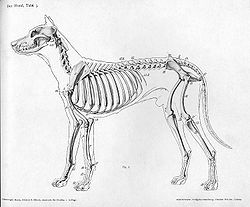
Domestic dogs have been selectively bred for millennia for various behaviors, sensory capabilities, and physical attributes.[60] Modern dog breeds show more variation in size, appearance, and behavior than any other domestic animal. Nevertheless, their morphology is based on that of their wild wolf ancestors.[60] Dogs are predators and scavengers, and like many other predatory mammals, the dog has powerful muscles, fused wrist bones, a cardiovascular system that supports both sprinting and endurance, and teeth for catching and tearing.
Dogs are highly variable in height and weight. The smallest known adult dog was a Yorkshire Terrier, that stood only 6.3 cm (2.5 in) at the shoulder, 9.5 cm (3.7 in) in length along the head-and-body, and weighed only 113 grams (4.0 oz). The largest known dog was an English Mastiff which weighed 155.6 kg (343 lb) and was 250 cm (98 in) from the snout to the tail.[108] The tallest dog is a Great Dane that stands 106.7 cm (42.0 in) at the shoulder.[109]
Senses
Vision
Like most mammals, dogs have only two types of cone photoreceptor, making them dichromats.[110][111][112][113] These cone cells are maximally sensitive between 429 nm and 555 nm. Behavioural studies have shown that the dog's visual world consists of yellows, blues and grays,[113] but they have difficulty differentiating red and green making their color vision equivalent to red–green color blindness in humans (deuteranopia). When a human perceives an object as "red", this object appears as "yellow" to the dog and the human perception of "green" appears as "white", a shade of gray. This white region (the neutral point) occurs around 480 nm, the part of the spectrum which appears blue-green to humans. For dogs, wavelengths longer than the neutral point cannot be distinguished from each other and all appear as yellow.[113]
Dogs use color instead of brightness to differentiate light or dark blue/yellow.[114][115][116][117] They are less sensitive to differences in grey shades than humans and also can detect brightness at about half the accuracy of humans.[118]
The dog's visual system has evolved to aid proficient hunting.[110] While a dog's visual acuity is poor (that of a poodle's has been estimated to translate to a Snellen rating of 20/75[110]), their visual discrimination for moving objects is very high; dogs have been shown to be able to discriminate between humans (e.g., identifying their human guardian) at a range of between 800 and 900 m, however this range decreases to 500–600 m if the object is stationary.[110]
Dogs have a temporal resolution of between 60 and 70 Hz. This means that domestic dogs are unlikely to perceive modern TV screens in the same way as humans because these are optimized for humans at 50–60 Hz.[118] Dogs can detect a change in movement that exists in a single diopter of space within their eye. Humans, by comparison, require a change of between 10 and 20 diopters to detect movement.[119]
As crepuscular hunters, dogs often rely on their vision in low light situations: They have very large pupils, a high density of rods in the fovea, an increased flicker rate, and a tapetum lucidum.[110] The tapetum is a reflective surface behind the retina that reflects light to give the photoreceptors a second chance to catch the photons. There is also a relationship between body size and overall diameter of the eye. A range of 9.5 and 11.6 mm can be found between various breeds of dogs. This 20% variance can be substantial and is associated as an adaptation toward superior night vision.[120]
The eyes of different breeds of dogs have different shapes, dimensions, and retina configurations.[121] Many long-nosed breeds have a "visual streak"—a wide foveal region that runs across the width of the retina and gives them a very wide field of excellent vision. Some long-muzzled breeds, in particular, the sighthounds, have a field of vision up to 270° (compared to 180° for humans). Short-nosed breeds, on the other hand, have an "area centralis": a central patch with up to three times the density of nerve endings as the visual streak, giving them detailed sight much more like a human's. Some broad-headed breeds with short noses have a field of vision similar to that of humans.[111][112]
Most breeds have good vision, but some show a genetic predisposition for myopia – such as Rottweilers, with which one out of every two has been found to be myopic.[110] Dogs also have a greater divergence of the eye axis than humans, enabling them to rotate their pupils farther in any direction. The divergence of the eye axis of dogs ranges from 12–25° depending on the breed.[119]
Experimentation has proven that dogs can distinguish between complex visual images such as that of a cube or a prism. Dogs also show attraction to static visual images such as the silhouette of a dog on a screen, their own reflections, or videos of dogs; however, their interest declines sharply once they are unable to make social contact with the image.[122]
Hearing
The frequency range of dog hearing is approximately 40 Hz to 60,000 Hz,[123] which means that dogs can detect sounds far beyond the upper limit of the human auditory spectrum.[112][123][124] In addition, dogs have ear mobility, which allows them to rapidly pinpoint the exact location of a sound.[125] Eighteen or more muscles can tilt, rotate, raise, or lower a dog's ear. A dog can identify a sound's location much faster than a human can, as well as hear sounds at four times the distance.[125]
Smell
While the human brain is dominated by a large visual cortex, the dog brain is dominated by an olfactory cortex.[110] The olfactory bulb in dogs is roughly forty times bigger than the olfactory bulb in humans, relative to total brain size, with 125 to 220 million smell-sensitive receptors.[110] The bloodhound exceeds this standard with nearly 300 million receptors.[110]
Consequently, it has been estimated that dogs, in general, have an olfactory sense ranging from one hundred thousand to one million times more sensitive than a human's. In some dog breeds, such as bloodhounds, the olfactory sense may be up to 100 million times greater than a human's.[126] The wet nose, or rhinarium, is essential for determining the direction of the air current containing the smell. Cold receptors in the skin are sensitive to the cooling of the skin by evaporation of the moisture by air currents.[127]
Physical characteristics
Coat
The coats of domestic dogs are of two varieties: "double" being common with dogs (as well as wolves) originating from colder climates, made up of a coarse guard hair and a soft down hair, or "single", with the topcoat only.
Domestic dogs often display the remnants of countershading, a common natural camouflage pattern.
A countershaded animal will have dark coloring on its upper surfaces and light coloring below,[128] which reduces its general visibility. Thus, many breeds will have an occasional "blaze", stripe, or "star" of white fur on their chest or underside.[129]
Tail
There are many different shapes for dog tails: straight, straight up, sickle, curled, or cork-screw. As with many canids, one of the primary functions of a dog's tail is to communicate their emotional state, which can be important in getting along with others. In some hunting dogs, however, the tail is traditionally docked to avoid injuries.[130] In some breeds, such as the Braque du Bourbonnais, puppies can be born with a short tail or no tail at all.[131]Types and breeds
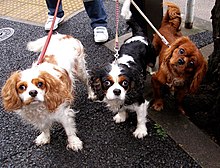
Cavalier King Charles Spaniels demonstrate within-breed variation.
Most breeds of dog are at most a few hundred years old, having been artificially selected for particular morphologies and behaviors by people for specific functional roles. Through this selective breeding, the dog has developed into hundreds of varied breeds, and shows more behavioral and morphological variation than any other land mammal.[132] For example, height measured to the withers ranges from 15.2 centimetres (6.0 in) in the Chihuahua to about 76 cm (30 in) in the Irish Wolfhound; color varies from white through grays (usually called "blue") to black, and browns from light (tan) to dark ("red" or "chocolate") in a wide variation of patterns; coats can be short or long, coarse-haired to wool-like, straight, curly, or smooth.[133] It is common for most breeds to shed this coat.
While all dogs are genetically very similar,[134] natural selection and selective breeding have reinforced certain characteristics in certain populations of dogs, giving rise to dog types and dog breeds. Dog types are broad categories based on function, genetics, or characteristics.[135] Dog breeds are groups of animals that possess a set of inherited characteristics that distinguishes them from other animals within the same species. Modern dog breeds are non-scientific classifications of dogs kept by modern kennel clubs.
Purebred dogs of one breed are genetically distinguishable from purebred dogs of other breeds,[136] but the means by which kennel clubs classify dogs is unsystematic. Systematic analyses of the dog genome has revealed only four major types of dogs that can be said to be statistically distinct.[136] These include the "old world dogs" (e.g., Malamute and Shar Pei), "Mastiff"-type (e.g., English Mastiff), "herding"-type (e.g., Border Collie), and "all others" (also called "modern"- or "hunting"-type).[136][137]
Health
Dogs are susceptible to various diseases, ailments, and poisons, some of which can affect humans. To defend against many common diseases, dogs are often vaccinated.There are many household plants that are poisonous to dogs including begonia, Poinsettia and aloe vera.[138] Poinsettia is often claimed to be toxic but this is untrue.
Some breeds of dogs are prone to certain genetic ailments such as elbow and hip dysplasia, blindness, deafness, pulmonic stenosis, cleft palate, and trick knees. Two serious medical conditions particularly affecting dogs are pyometra, affecting unspayed females of all types and ages, and bloat, which affects the larger breeds or deep-chested dogs. Both of these are acute conditions, and can kill rapidly. Dogs are also susceptible to parasites such as fleas, ticks, and mites, as well as hookworms, tapeworms, roundworms, and heartworms.
A number of common human foods and household ingestibles are toxic to dogs, including chocolate solids (theobromine poisoning), onion and garlic (thiosulphate, sulfoxide or disulfide poisoning),[139] grapes and raisins, macadamia nuts, xylitol,[140] as well as various plants and other potentially ingested materials.[141][142] The nicotine in tobacco can also be dangerous. Dogs can get it by scavenging in garbage or ashtrays; eating cigars and cigarettes. Signs can be vomiting of large amounts (e.g., from eating cigar butts) or diarrhea. Some other signs are abdominal pain, loss of coordination, collapse, or death. [143] Dogs are highly susceptible to theobromine poisoning, typically from ingestion of chocolate. Theobromine is toxic to dogs because, although the dog's metabolism is capable of breaking down the chemical, the process is so slow that even small amounts of chocolate can be fatal, especially dark chocolate.
Dogs are also vulnerable to some of the same health conditions as humans, including diabetes, dental and heart disease, epilepsy, cancer, hypothyroidism, and arthritis.[144]
Lifespan
The typical lifespan of dogs varies widely among breeds, but for most the median longevity, the age at which half the dogs in a population have died and half are still alive, ranges from 10 to 13 years.[145][146][147][148] Individual dogs may live well beyond the median of their breed.
The breed with the shortest lifespan (among breeds for which there is a questionnaire survey with a reasonable sample size) is the Dogue de Bordeaux, with a median longevity of about 5.2 years, but several breeds, including Miniature Bull Terriers, Bloodhounds, and Irish Wolfhounds are nearly as short-lived, with median longevities of 6 to 7 years.[148]
The longest-lived breeds, including Toy Poodles, Japanese Spitz, Border Terriers, and Tibetan Spaniels, have median longevities of 14 to 15 years.[148] The median longevity of mixed-breed dogs, taken as an average of all sizes, is one or more years longer than that of purebred dogs when all breeds are averaged.[146][147][148][149] The dog widely reported to be the longest-lived is "Bluey", who died in 1939 and was claimed to be 29.5 years old at the time of his death; however, the Bluey record is anecdotal and unverified.[150] On 5 December 2011, Pusuke, the world's oldest living dog recognized by Guinness Book of World Records, died aged 26 years and 9 months.[151]
Predation
Although large wild dogs, like wolves, are apex predators,[152] they can be killed in territory disputes with wild animals.[153] Furthermore, in areas where both dogs and other large predators live, dogs can be a major food source for big cats or canines. Reports from Croatia indicate wolves kill dogs more frequently than they kill sheep. Wolves in Russia apparently limit feral dog populations. In Wisconsin, more compensation has been paid for dog losses than livestock.[153] Some wolf pairs have been reported to prey on dogs by having one wolf lure the dog out into heavy brush where the second animal waits in ambush.[154] In some instances, wolves have displayed an uncharacteristic fearlessness of humans and buildings when attacking dogs, to the extent that they have to be beaten off or killed.[155]Coyotes and big cats have also been known to attack dogs. Leopards in particular are known to have a predilection for dogs, and have been recorded to kill and consume them regardless of the dog's size or ferocity.[156] Tigers in Manchuria, Indochina, Indonesia, and Malaysia are reputed to kill dogs with the same vigor as leopards.[157] Striped Hyenas are major predators of village dogs in Turkmenistan, India, and the Caucasus.[158] Reptiles such as alligators and pythons have been known to kill and eat dogs.
Diet

Golden Retriever gnawing a pig's foot
Despite their descent from wolves and classification as Carnivora, dogs are variously described in scholarly and other writings as carnivores[159][160] or omnivores.[60][161][162][163] Unlike obligate carnivores, such as the cat family with its shorter small intestine, dogs can adapt to a wide-ranging diet, and are not dependent on meat-specific protein nor a very high level of protein in order to fulfill their basic dietary requirements. Dogs will healthily digest a variety of foods, including vegetables and grains, and can consume a large proportion of these in their diet.[60] Compared to their wolf ancestors, dogs have adaptations in genes involved in starch digestion that contribute to an increased ability to thrive on a starch-rich diet.[164]
Reproduction
In domestic dogs, sexual maturity begins to happen around age six to twelve months for both males and females,[60][165] although this can be delayed until up to two years old for some large breeds. This is the time at which female dogs will have their first estrous cycle. They will experience subsequent estrous cycles biannually, during which the body prepares for pregnancy. At the peak of the cycle, females will come into estrus, being mentally and physically receptive to copulation.[60] Because the ova survive and are capable of being fertilized for a week after ovulation, it is possible for a female to mate with more than one male.[60]2–5 days post conception fertilization occurs, 14–16 days embryo attaches to uterus 22–23 days heart beat is detectable.[166][167]
Dogs bear their litters roughly 58 to 68 days after fertilization,[60][168] with an average of 63 days, although the length of gestation can vary. An average litter consists of about six puppies,[169] though this number may vary widely based on the breed of dog. In general, toy dogs produce from one to four puppies in each litter, while much larger breeds may average as many as twelve.
Some dog breeds have acquired traits through selective breeding that interfere with reproduction. Male French Bulldogs, for instance, are incapable of mounting the female. For many dogs of this breed, the female must be artificially inseminated in order to reproduce.[170]
Neutering
Neutering refers to the sterilization of animals, usually by removal of the male's testicles or the female's ovaries and uterus, in order to eliminate the ability to procreate and reduce sex drive. Because of the overpopulation of dogs in some countries, many animal control agencies, such as the American Society for the Prevention of Cruelty to Animals (ASPCA), advise that dogs not intended for further breeding should be neutered, so that they do not have undesired puppies that may have to later be euthanized.[171]
According to the Humane Society of the United States, 3–4 million dogs and cats are put down each year in the United States and many more are confined to cages in shelters because there are many more animals than there are homes. Spaying or castrating dogs helps keep overpopulation down.[172] Local humane societies, SPCAs, and other animal protection organizations urge people to neuter their pets and to adopt animals from shelters instead of purchasing them.
Neutering reduces problems caused by hypersexuality, especially in male dogs.[173] Spayed female dogs are less likely to develop some forms of cancer, affecting mammary glands, ovaries, and other reproductive organs.[174] However, neutering increases the risk of urinary incontinence in female dogs,[175] and prostate cancer in males,[176] as well as osteosarcoma, hemangiosarcoma, cruciate ligament rupture, obesity, and diabetes mellitus in either sex.[177]
Communication
By the age of four weeks, the dog has developed the majority of its vocalizations.[178] The dog is the most vocal canid and is unique in its tendency to bark in a myriad of situations.[178]Barking appears to have little more communication functions than excitement, fighting, the presence of a human, or simply because other dogs are barking.[178] Subtler signs such as discreet bodily and facial movements, body odors, whines, yelps, and growls are the main sources of actual communication.[178] The majority of these subtle communication techniques are employed at a close proximity to another, but for long-range communication only barking and howling are employed.[178]
Intelligence and behavior
Intelligence

The domestic dog has a predisposition to exhibit a social intelligence that is uncommon in the animal world.[110] Dogs are capable of learning in a number of ways, such as through simple reinforcement (e.g., classical or operant conditioning) and by observation.[110][180]
Dogs go through a series of stages of cognitive development. As with humans, the understanding that objects not being actively perceived still remain in existence (called object permanence) is not present at birth. It develops as the young dog learns to interact intentionally with objects around it, at roughly 8 weeks of age.[110]
Puppies learn behaviors quickly by following examples set by experienced dogs.[110] This form of intelligence is not peculiar to those tasks dogs have been bred to perform, but can be generalized to myriad abstract problems. For example, Dachshund puppies that watched an experienced dog pull a cart by tugging on an attached piece of ribbon in order to get a reward from inside the cart learned the task fifteen times faster than those left to solve the problem on their own.[110][181]
Dogs can also learn by mimicking human behaviors. In one study, puppies were presented with a box, and shown that, when a handler pressed a lever, a ball would roll out of the box. The handler then allowed the puppy to play with the ball, making it an intrinsic reward. The pups were then allowed to interact with the box. Roughly three quarters of the puppies subsequently touched the lever, and over half successfully released the ball, compared to only 6% in a control group that did not watch the human manipulate the lever.[182] Another study found that handing an object between experimenters who then used the object's name in a sentence successfully taught an observing dog each object's name, allowing the dog to subsequently retrieve the item.[183]

Sergeant Stubby wearing his uniform and medals. Stubby participated in four offensives and 17 battles.
Dogs also demonstrate sophisticated social cognition by associating behavioral cues with abstract meanings.[110] One such class of social cognition involves the understanding that others are conscious agents. Research has shown that dogs are capable of interpreting subtle social cues, and appear to recognize when a human or dog's attention is focused on them. To test this, researchers devised a task in which a reward was hidden underneath one of two buckets. The experimenter then attempted to communicate with the dog to indicate the location of the reward by using a wide range of signals: tapping the bucket, pointing to the bucket, nodding to the bucket, or simply looking at the bucket.[184](pp1634–6) The results showed that domestic dogs were better than chimpanzees, wolves, and human infants at this task, and even young puppies with limited exposure to humans performed well.[110]
Psychology research has shown that humans' gaze instinctively moves to the left in order to watch the right side of a person's face, which is related to use of right hemisphere brain for facial recognition, including human facial emotions. Research at the University of Lincoln (2008) shows that dogs share this instinct when meeting a human being, and only when meeting a human being (i.e., not other animals or other dogs). As such they are the only non-primate species known to do so.[185][186]
Stanley Coren, an expert on dog psychology, states that these results demonstrated the social cognition of dogs can exceed that of even our closest genetic relatives, and that this capacity is a recent genetic acquisition that distinguishes the dog from its ancestor, the wolf.[110] Studies have also investigated whether dogs engaged in partnered play change their behavior depending on the attention-state of their partner.[187] Those studies showed that play signals were only sent when the dog was holding the attention of its partner. If the partner was distracted, the dog instead engaged in attention-getting behavior before sending a play signal.[187]
Coren has also argued that dogs demonstrate a sophisticated theory of mind by engaging in deception, which he supports with a number of anecdotes, including one example wherein a dog hid a stolen treat by sitting on it until the rightful owner of the treat left the room.[110] Although this could have been accidental, Coren suggests that the thief understood that the treat's owner would be unable to find the treat if it were out of view. Together, the empirical data and anecdotal evidence points to dogs possessing at least a limited form of theory of mind.[110][187] Similar research has been performed by Brian Hare of Duke University, who has shown that dogs outperform both great apes as well as wolves raised by humans in reading human communicative signals.[184](pp1634–6)[188]
A study found a third of dogs suffered from anxiety when separated from others.[189]
A border collie named Chaser has learned the names for 1,022 toys after three years of training, so many that her trainers have had to mark the names of the objects lest they forget themselves. This is higher than Rico, another border collie who could remember at least 200 objects.[190]
Behavior
Although dogs have been the subject of a great deal of behaviorist psychology (e.g. Pavlov's dog), they do not enter the world with a psychological "blank slate".[110] Rather, dog behavior is affected by genetic as well as environmental factors.[110] Domestic dogs exhibit a number of behaviors and predispositions that were inherited from wolves.[110]After undergoing training to solve a simple manipulation task, dogs that are faced with an insoluble version of the same problem look at the human, while socialized wolves do not.[191]
Given that dogs' abilities to use human social cues originated during the process of domestication, it is likely that individual dogs that were able to use social cues to predict the behavior of humans more flexibly than could their last common wolf ancestor were at a selective advantage.[184]
The existence and nature of personality traits in dogs has been studied (15329 dogs of 164 different breeds) and five consistent and stable "narrow traits" identified, described as playfulness, curiosity/fearlessness, chase-proneness, sociability and aggressiveness. A further higher order axis for shyness–boldness was also identified.[192][193]
The average sleep time of a dog is said to be 10.1 hours per day.[194] Like humans, dogs have two main types of sleep: slow-wave sleep, then rapid eye movement sleep, the state in which dreams occur.[195]
Dogs prefer, when they are off the leash and Earth's magnetic field is calm, to urinate and defecate with their bodies aligned on a north-south axis.[196]
Dog growl
A new study in Budapest, Hungary, has found that dogs are able to tell how big another dog is just by listening to its growl. A specific growl is used by dogs to protect their food. The research also shows that dogs do not, or can not, misrepresent their size, and this is the first time research has shown animals can determine another's size by the sound it makes. The test, using images of many kinds of dogs, showed a small and big dog and played a growl. The result showed that 20 of the 24 test dogs looked at the image of the appropriately sized dog first and looked at it longest.[197]Differences from wolves
Physical characteristics
Compared to equally sized wolves, dogs tend to have 20% smaller skulls, 30% smaller brains,[59]:35 as well as proportionately smaller teeth than other canid species.[198] Dogs require fewer calories to function than wolves. It is thought by certain experts that the dog's limp ears are a result of atrophy of the jaw muscles.[198] The skin of domestic dogs tends to be thicker than that of wolves, with some Inuit tribes favoring the former for use as clothing due to its greater resistance to wear and tear in harsh weather.[198] Wolves do not have dewclaws on their back legs, unless there has been admixture with dogs.[199]Behavioral differences
Dogs tend to be poorer than wolves at observational learning, being more responsive to instrumental conditioning.[198] Feral dogs show little of the complex social structure or dominance hierarchy present in wolf packs. For example, unlike wolves, the dominant alpha pairs of a feral dog pack do not force the other members to wait for their turn on a meal when scavenging off a dead ungulate as the whole family is free to join in. For dogs, other members of their kind are of no help in locating food items, and are more like competitors.[198]Feral dogs are primarily scavengers, with studies showing that unlike their wild cousins, they are poor ungulate hunters, having little impact on wildlife populations where they are sympatric. However, feral dogs have been reported to be effective hunters of reptiles in the Galápagos Islands,[59]:267 and free ranging pet dogs are more prone to predatory behavior toward wild animals.
Domestic dogs can be monogamous.[200] Breeding in feral packs can be, but does not have to be restricted to a dominant alpha pair (such things also occur in wolf packs).[201] Male dogs are unusual among canids by the fact that they mostly seem to play no role in raising their puppies, and do not kill the young of other females to increase their own reproductive success.[59]:267 Some sources say that dogs differ from wolves and most other large canid species by the fact that they do not regurgitate food for their young, nor the young of other dogs in the same territory.[198]
However, this difference was not observed in all domestic dogs. Regurgitating of food by the females for the young as well as care for the young by the males has been observed in domestic dogs, dingos as well as in other feral or semi-feral dogs. Regurgitating of food by the females and direct choosing of only one mate has been observed even in those semi-feral dogs of direct domestic dog ancestry.
Also regurgitating of food by males has been observed in free-ranging domestic dogs.[200][202]
In 1982, a study to observe the differences between dogs and wolves raised in similar conditions took place.[203] The dog puppies preferred larger amounts of sleep at the beginning of their lives, while the wolf puppies were much more active.[203] The dog puppies also preferred the company of humans, rather than their canine foster mother, though the wolf puppies were the exact opposite, spending more time with their foster mother.[203] The dogs also showed a greater interest in the food given to them and paid little attention to their surroundings, while the wolf puppies found their surroundings to be much more intriguing than their food or food bowl.[203] The wolf puppies were observed taking part in agonistic play at a younger age, while the dog puppies did not display dominant/submissive roles until they were much older.[203] The wolf puppies were rarely seen as being aggressive to each other or towards the other canines.[203] On the other hand, the dog puppies were much more aggressive to each other and other canines, often seen full-on attacking their foster mother or one another.[203]
Trainability
Dogs display much greater tractability than tame wolves, and are, in general, much more responsive to coercive techniques involving fear, aversive stimuli, and force than wolves, which are most responsive toward positive conditioning and rewards.[204] Unlike tame wolves, dogs tend to respond more to voice than hand signals.[205]Cultural depictions
Mythology
In mythology, dogs often serve as pets or as watchdogs.[206]
In Greek mythology, Cerberus is a three-headed watchdog who guards the gates of Hades.[206] In Norse mythology, a bloody, four-eyed dog called Garmr guards Helheim.[206] In Persian mythology, two four-eyed dogs guard the Chinvat Bridge.[206] In Philippine mythology, Kimat who is the pet of Tadaklan, god of thunder, is responsible for lightning. In Welsh mythology, Annwn is guarded by Cŵn Annwn.[206]
In Hindu mythology, Yama, the god of death owns two watch dogs who have four eyes. They are said to watch over the gates of Naraka.[207] Hunter god Muthappan from North Malabar region of Kerala has a hunting dog as his mount. Dogs are found in and out of the Muthappan Temple and offerings at the shrine take the form of bronze dog figurines.[208]
In Judaism and Islam, dogs are viewed as unclean scavengers.[206] In Christianity, dogs represent faithfulness.[206] In Asian countries such as China, Korea, and Japan, dogs are viewed as kind protectors.[206] The role of the dog in Chinese mythology includes a position as one of the twelve animals which cyclically represent years (the zodiacal dog).
Gallery of dogs in art
|
Ancient Greek rhyton in the shape of a dog's head, made by Brygos, early 5th century BC. Jérôme Carcopino Museum, Department of Archaeology, Aleria
| Wikimedia Commons has media related to Dogs in art. |

